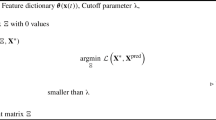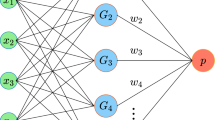Abstract
Generally, memoryless polynomial nonlinear model for nonlinear part and finite impulse response (FIR) model or infinite impulse response model for linear part are preferred in Hammerstein models in literature. In this paper, system identification applications of Hammerstein model that is cascade of nonlinear second order volterra and linear FIR model are studied. Recursive least square algorithm is used to identify the proposed Hammerstein model parameters. Furthermore, the results are compared to identify the success of proposed Hammerstein model and different types of models.











Similar content being viewed by others
References
Ding F, Wang Y and Ding J 2015 Recursive least squares parameter identification algorithms for systems with colored noise using the filtering technique and the auxilary model. Digital Signal Process. 37: 100–108, doi:10.1016/j.dsp.2014.10.005
Ding F, Liu X P and Liu G 2011 Identification methods for Hammerstein nonlinear systems. Digital Signal Process. 21(2): 215–238
Erçin Ö and Çoban R 2012 Identification of linear dynamic systems using the artificial bee colony algorithm. Turk. J. Electr. Eng. Comput. Sci. 20(1): 1175–1188
Hizir N B, Phan M Q, Betti R and Longman R W 2012 Identification of discrete-time bilinear systems through equivalent linear models. Nonlinear Dyn. 69(4): 2065–2078
Hong X, Mitchell R J, Chen S, Harris C J, Li K and Irwin G W 2008 Model selection approaches for non-linear system identification: A review. Int. J. Syst. Sci. 39(10): 925–946
Manohar C S and Roy D 2006 Monte Carlo filters for identification of nonlinear structural dynamical systems. Sadhana Acad. Proc. Eng. Sci. 31(4): 399–427
Naitali A and Giri F 2015 Wiener–Hammerstein system identification an evolutionary approach. Int. J. Syst. Sci. 47(1): 45–61
Özer Ş and Zorlu H 2011 Identification of bilinear systems using differential evolution algorithm. Sadhana Acad. Proc. Eng. Sci. 36(3): 281–292
Rahrooh A and Shepard S 2009 Identification of nonlinear systems using NARMAX model. Nonlinear Anal. 71(12): 1198–1202
Schweickhardt T and Allgöwer F 2009 On system gains, nonlinearity measures, and linear models for nonlinear systems. IEEE Trans. Autom. Control 54(1): 62–78
Özer Ş and Zorlu H 2012 Chaotic time series prediction using the nonlinear PAR systems. J. Faculty Eng. Architecture Gazi Univ. 27(2): 323–331
Bao C, Hao H and Li Z X 2013 Integrated ARMA model method for damage detection of subsea pipeline system. Eng. Struct. 48: 176–192, doi:10.1016/j.engstruct.2012.09.033
Caillec J M L 2008 Hypothesis testing for nonlinearity detection based on an MA model. IEEE Trans. Signal Process. 56(2): 816–821
Coelho L D S and Pessoa M W 2009 Nonlinear model identification of an experimental ball-and-tube system using a genetic programming approach. Mech. Syst. Signal Process. 23(5): 1434–1446
Diniz P S R 2008 Adaptive filtering algorithms and practical implemantations, Springer Verlag, USA
Maachou A, Malti R, Melchior P, Battaglia J L, Oustaloup A and Hay B 2014 Nonlinear thermal system identification using fractional Volterra series. Control Eng. Practice 29: 50–60, doi:10.1016/j.conengprac.2014.02.023
Schmidt C A, Biagiola S I, Cousseau J E and Figueroa J L 2014 Volterra-type models for nonlinear systems identification. Appl. Math. Modell. 38(9–10): 2414–2421
Wang Y J and Ding F 2016 Iterative estimation for a nonlinear IIR filter with moving average noise by means of the data filtering technique. IMA J. Math. Control Inform. doi:10.1093/imamci/dnv067
Zorlu H 2011 Identification of nonlinear systems with soft computing techniques. PhD dissertation, Erciyes University, Graduate School of Natural and Applied Science, Turkey
Cui M, Liu H, Li Z, Tang Y and Guan X 2014 Identification of Hammerstein model using functional link artificial neural network. Neuro Comput. 142: 419–428, doi:10.1016/j.neucom.2014.03.051
Ding F, Ma J and Xiao Y 2013 Newton iterative identification for a class of output nonlinear systems with moving average noises. Nonlinear Dyn. 74(1): 21–30
Ding F and Chen T 2005 Identification of Hammerstein nonlinear ARMAX systems. Automatica 41(9): 1479–1489
Ding F, Shi Y and Chen T 2007 Auxiliary model-based least-squares identification methods for Hammerstein output-error systems. Syst. Control Lett. 56(5): 373–380
Gotmare A, Patidar R and George N V 2015 Nonlinear system identification using a cuckoo search optimized adaptive Hammerstein model. Expert Syst. Appl. 42(5): 2538–2546
Hafsi S, Laabidi K and Lahmari M K 2012 Identification of Wiener-Hammerstein model with multi segment piecewise-linear characteristic. In: 16th IEEE Mediterranean Electrotechnical Conference (MELECON), Tunisia, 5–10, doi:10.1109/MELCON.2012.6196367
Khani F and Haeri M 2015 Robust model predictive control of nonlinear processes represented by Wiener or Hammerstein models. Chem. Eng. Sci. 129: 223–231, doi:10.1016/j.ces.2015.02.021
Mao Y and Ding F 2015 Multi-innovation stochastic gradient identification for Hammerstein controlled autoregressive autoregressive systems based on the filtering technique. Nonlinear Dyn. 79(3): 1745–1755
Tang Y, Li Z and Guan X 2014 Identification of nonlinear system using extreme learning machine based Hammerstein model. Commun. Nonlinear Sci. Numer. Simul. 19(9): 3171–3183
Wang D Q and Ding F 2011 Least squares based and gradient based iterative identification for Wiener nonlinear systems. Signal Process. 91(5): 1182–1189
Wang D Q, Liu H B and Ding F 2015 Highly efficient identification methods for dual-rate Hammerstein systems. IEEE Trans. Control Syst. Technol. 23(5): 1952–1960
Wang D Q and Ding F 2012 Hierarchical least squares estimation algorithm for Hammerstein-Wiener systems. IEEE Signal Process. Lett. 19(12): 825–828
Wang D Q and Zhang W 2015 Improved least squares identification algorithm for multivariable Hammerstein systems. J. Franklin Inst. – Eng. Appl. Math. 352(11): 5292–5307
Wills A, Schön T B, Ljung L and Ninness B 2013 Identification of Hammerstein–Wiener models. Automatica 49(1): 70–81
Aguirre L A, Coelhoand M C S and Correa M V 2005 On the interpretation and practice of dynamical differences between Hammerstein and Wiener models. IEE Proc. Control Theory Appl. 152(4): 349–356
Lin W and Liu P X 2006 Hammerstein model identification based on bacterial foraging. IET J. 42(23): 1332–1333
Jeraj J and Mathews V J 2006 Stochastic mean-square performance analysis of an adaptive Hammerstein filter. IEEE Trans. Signal Process. 54(6): 2168– 2177
Jeraj J, Mathews V J and Dubow J 2006 A stable adaptive Hammerstein filter employing partial orthogonalization of the input signals. IEEE Trans. Signal Process. 54(4): 1412–1420
Sbeity F, Girault J M, Ménigot S and Charara J 2012 Sub and ultra harmonic extraction using several Hammerstein models. In: International Conference on Complex Systems (ICCS), Morocco, 1–5, doi:10.1109/ICoCS.2012.6458608
Guo F 2004 A new identification method for Wiener and Hammerstein systems. PhD dissertation. Karlsruhe Univeristy, Institut fur Angewandte Informatik, Germany
Sappal A S 2011 To develop a linearization technique for mitigating the RF power amplifier’s nonlinearity effects in a multi carrier W-CDMA base station. PhD dissertation, Punjabi University, India
Chen B, Zhu Y, Hu J and Principe J C 2011 A variable step-size SIG algorithm for realizing the optimal adaptive FIR filter. Int. J. Control Autom. Syst. 9(6): 1049–1055
Mete S, Ozer S and Zorlu H 2014 System identification using Hammerstein model. In: 22nd Signal Processing and Communications Applications Conference (SIU), Turkey, 1303–1306, doi:10.1109/SIU.2014.6830476
Ding F, Wang X H, Chen Q J and Y S Xiao 2016 Recursive least squares parameter estimation for a class of output nonlinear systems based on the model decomposition. Circuits Syst. Signal Process. 35, doi:10.1007/s00034-015-0190-6
Kozek M and Hametner C 2007 Block-oriented identification of Hammerstein/Wiener models using the RLS algorithm. Int. J. Appl. Electromagn. Mech. 25(1–4): 529– 535
Kara T 2005 Adaptive control of nonlinear systems with applications. PhD dissertation. University of Gaziantep, Electrical and Electronics Engineering, Turkey
Cetinkaya M B 2010 Digital filter design by using artificial bee colony algorithm. PhD dissertation, Erciyes University, Graduate School of Natural and Applied Sciences, Turkey
Sayadi M, Chaari A, Fnaiech F and Najim M 1996 A fast M-D chandrasekhar algorithm for second order Volterra adaptive filtering. In: IEEE International Conference on Acoustics, Speech and Signal Processing (ICASSP) (3): 1339–1342, doi:10.1109/ICASSP.1996.543674
Özer Ş, Zorlu H and Mete S 2014 System identification using Wiener model. In: Conference on Electrical, Electronics and Computer Engineering (ELECO), Turkey, 543–547
Stogioglou A G and McLaughlin S 1994 New results in system identification of FIR systems. In: Conference Record of the Twenty-Eighth Asilomar Conference on Signals, Systems and Computers 1: 430–434, doi:10.1109/ACSSC.1994.471490
Acknowledgment
This work is supported by Research Fund of Erciyes University (Project code: FDK-2014-5308).
Author information
Authors and Affiliations
Corresponding author
Rights and permissions
About this article
Cite this article
Ozer, S., Zorlu, H. & Mete, S. System identification application using Hammerstein model. Sādhanā 41, 597–605 (2016). https://doi.org/10.1007/s12046-016-0505-8
Received:
Revised:
Accepted:
Published:
Issue Date:
DOI: https://doi.org/10.1007/s12046-016-0505-8




